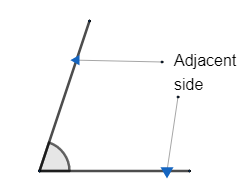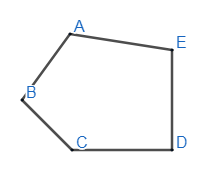
Adjacent sides of polygon are:
A. Any two sides of the polygon
B. Any two sides of connecting two non-consecutive vertices of a polygon
C. Any two sides with a common vertex
D. None of these
Answer
594k+ views
Hint: Draw a polygon which is a closed figure, bounded by straight line segments. Now compare any 2 sides of the polygon we have drawn. It can be a triangle, rectangle or any figure. Compare the adjacent sides.
Complete step-by-step answer:
Adjacent sides of a polygon are two lines that meet at the vertex of a polygon. They can be usually found in triangles and other polygons. The two sides that meet at a vertex of the polygon are called the adjacent side. This can be understood clearly by the diagram.

We can also take an example of a different polygon which is a closed figure, bounded by a straight line segment.

Observe the polygon we have drawn. The line segments forming a polygon are called its sides. The sides of the given polygon are AB, BC, CD, DE and EA.
Let us check the side AB and BC for example. AB has endpoint B and BC has an end point B. in AB and BC has common end point B. Thus, we can call AB and BC as the adjacent sides of the polygon. Thus any two sides having a common end point are adjacent sides. The other pair of adjacent sides of the polygon are B and CD, CD and DE, DE and EA, and EA and AB.
Similarly we can take other examples of polygons like triangle, cube, rectangle or any quadrilateral.
$\therefore $ Adjacent sides of a polygon are any two sides with a common vertex.
$\therefore $ Option (C) is the correct answer.
Note: Now consecutive sides are two sides of a polygon which share a common angle. We can see consecutive sides in any figure such as triangle, rectangle etc.Students should remember 3 characteristics of polygons. (1) Polygon is a closed shape in the plane, (2) the sides of a polygon are line segments, and (3) the sides of a polygon meet only at endpoints.
Complete step-by-step answer:
Adjacent sides of a polygon are two lines that meet at the vertex of a polygon. They can be usually found in triangles and other polygons. The two sides that meet at a vertex of the polygon are called the adjacent side. This can be understood clearly by the diagram.

We can also take an example of a different polygon which is a closed figure, bounded by a straight line segment.

Observe the polygon we have drawn. The line segments forming a polygon are called its sides. The sides of the given polygon are AB, BC, CD, DE and EA.
Let us check the side AB and BC for example. AB has endpoint B and BC has an end point B. in AB and BC has common end point B. Thus, we can call AB and BC as the adjacent sides of the polygon. Thus any two sides having a common end point are adjacent sides. The other pair of adjacent sides of the polygon are B and CD, CD and DE, DE and EA, and EA and AB.
Similarly we can take other examples of polygons like triangle, cube, rectangle or any quadrilateral.
$\therefore $ Adjacent sides of a polygon are any two sides with a common vertex.
$\therefore $ Option (C) is the correct answer.
Note: Now consecutive sides are two sides of a polygon which share a common angle. We can see consecutive sides in any figure such as triangle, rectangle etc.Students should remember 3 characteristics of polygons. (1) Polygon is a closed shape in the plane, (2) the sides of a polygon are line segments, and (3) the sides of a polygon meet only at endpoints.
Recently Updated Pages
Master Class 12 Business Studies: Engaging Questions & Answers for Success

Master Class 12 Economics: Engaging Questions & Answers for Success

Master Class 12 English: Engaging Questions & Answers for Success

Master Class 12 Maths: Engaging Questions & Answers for Success

Master Class 12 Social Science: Engaging Questions & Answers for Success

Master Class 12 Chemistry: Engaging Questions & Answers for Success

Trending doubts
Who was the first woman to receive Bharat Ratna?

Write a letter to the principal requesting him to grant class 10 english CBSE

Why is there a time difference of about 5 hours between class 10 social science CBSE

What is the median of the first 10 natural numbers class 10 maths CBSE

The Equation xxx + 2 is Satisfied when x is Equal to Class 10 Maths

Discuss the main reasons for poverty in India




